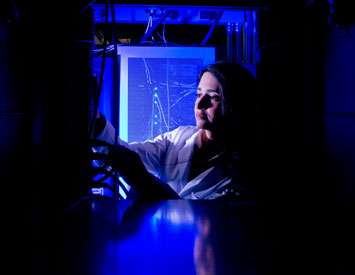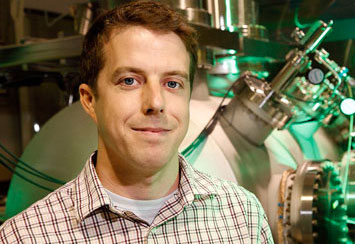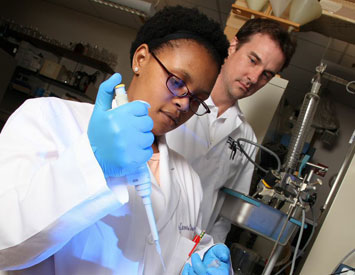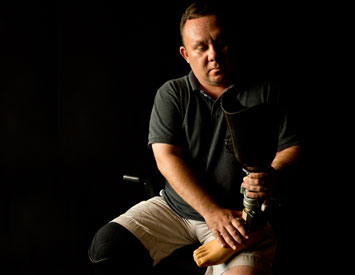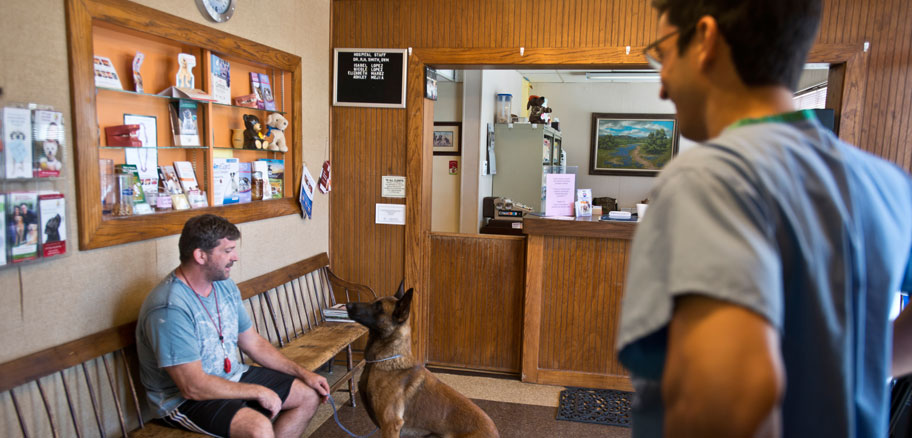
Cradle of Knowledge
From leading the charge in cybersecurity advancements to shaping the success of an unlikely inventor, UTSA is home to student and faculty research thatÔÇÖs making a world of change
Ramon Coronado ÔÇÖ11 stood in the exam room doorway at the Animal Hospital of San Antonio waiting for word that the patient -- a purebred Belgian Malinois named Vader -- would soon be ready. Only CoronadoÔÇÖs quick glances across the hall, his eyes landing on a closed door that shielded another exam room, belied his relaxed demeanor. ÔÇťTiming is very important,ÔÇŁ he says about the upcoming procedure.
His business partner and fellow UTSA Ph.D. biomedical engineering student, Tony Yuan, was close by, checking to make sure the centrifuge and sterilization hood on the exam table were ready.
The two were at the clinic not as students but as owners of their new business, Mobile Stem Care, which provides stem-cell therapy services to veterinary clinics. And on that afternoon, all they needed to go to work was for Vader to go to sleep.
Applying expertise with entrepreneurship is just one way UTSA strives to enhance programs, stay competitive, and recruit faculty and students who will help the university reach Tier One status, says Vice President for Research Mauli Agrawal. ÔÇťWhat differentiates us from anyone else is looking at what the person does with the knowledge, how creative the mind is,ÔÇŁ he says. ÔÇťAnd that goes across all disciplines -- whether an engineer, scientist, musician or historian. Can they do critical thinking? Can they innovate? Because I think both are needed -- well-rounded students with a lot of knowledge who are also creative thinkers.ÔÇŁ
With an overarching objective to be a nationally recognized research university with global impact, complacency is not an option. Building on the current strategic plan that laid out ways to grow five areas of research by 2016, the goal for the next 10 years is to strengthen programs where the university already excels, like cybersecurity and cloud technology, integrative biomedicine, materials science, and social and educational transformation. ÔÇťWe want to concentrate in certain areas and hire in clusters,ÔÇŁ Agrawal says. ÔÇťSo itÔÇÖs the same subject but people are looking at it from all angles, different perspectives, through different lenses. Collectively, we become the true expert nationally in that area.ÔÇŁ
Through the GoldStar Initiative, the university is committing $40 million to hire 60 research-focused faculty members over the next four years. UTSA also wants to expand collaborations with other universities and research institutions in the public and private sectors and to develop partnerships around the globe, says Agrawal, who holds the Peter T. Flawn Professorship in Biomedical Engineering. ÔÇťThereÔÇÖs always going to be a local relevance tied to it, but the problems addressed through research are no longer limited to just one region,ÔÇŁ he says. ÔÇťThey are global problems. Whether itÔÇÖs energy or water or disease, itÔÇÖs not just our problem; itÔÇÖs everyoneÔÇÖs problem.ÔÇŁ
Cybersecurity Priorities
Bexar County Commissioner Kevin Wolff leaned back in his office chair and put his hands behind his head. ÔÇťItÔÇÖs interesting now that I think about it,ÔÇŁ he says. ÔÇťI canÔÇÖt remember a meeting -- either AACOG or county -- when anyone asked about cybersecurity, not even just a presentation to say ÔÇśHereÔÇÖs what weÔÇÖre doing.ÔÇÖÔÇŁ
Wolff, who is also chairman of the Alamo Area Council of Governments, which facilitates training among the 13-county membership, says that doesnÔÇÖt mean government leaders havenÔÇÖt thought or talked about it. Even so, more resources would be welcome.
That is a void the UTSA Center for Infrastructure Assurance and Security hopes to fill, according to Gregory B. White, director of CIAS. ÔÇťHow do you organize a cybersecurity program?ÔÇŁ he says. ÔÇťHow do you respond to cyber incidents? How do they relate to normal first responders? What are the threats?ÔÇŁ
This past spring the CIAS was awarded $800,000 from the federal government to create the National Cybersecurity Preparedness Consortium, which will help communities prepare for, detect and respond to cyber attacks in a consistent manner. Like first responders get training on natural disaster preparedness and response from the Federal Emergency Management Agency, the consortium would provide cyber disaster preparedness and response. ÔÇťThere are a lot of communities that do not have the funds to hire a full-time person,ÔÇŁ White says. ÔÇťThose communities really need an entity they can turn to in order to get some help.ÔÇŁ
UTSA is also poised to provide cybersecurity training for the future workforce -- starting as young as elementary school. By the end of this year Los Angeles and possibly San Antonio students in grades K-12 could be learning about cyber safety via a program the CIAS created in conjunction with CyberPatriot, an Air Force Association program that created to get students interested in cybersecurity or other STEM disciplines. The CIAS-produced software is the first for elementary schools. It teaches children about online safety and awareness as well as cyber etiquette.
Students also express a greater interest in STEM fields -- science, technology, engineering and math -- because of the program, says Chris Cook, volunteer liaison for San AntonioÔÇÖs CyberPatriot programs. ÔÇťSome of the best salaries in the country are in IT in San Antonio, and the best of those are in cybersecurity,ÔÇŁ he says. ÔÇťWeÔÇÖve got the number 2 best cybersecurity workforce in San Antonio. So thatÔÇÖs what we are building on.ÔÇŁ
Programs at UTSA also continue to build to meet educational demand. The university has been named the number 1 school for cybersecurity education and, as one of 44 universities nationwide, a National Center of Academic Excellence in Information Assurance and Cyber Defense.
Deep Space Collaboration
George Clark ÔÇÖ14 has always had a love for travel. Now, he is a space explorer without ever leaving the Earth. As part of UTSAÔÇÖs Ph.D. program in physics in collaboration with Southwest Research Institute, or SwRI, Clark worked on the Cassini and Juno projects, which included data collection from Saturn and Jupiter, respectively.
ÔÇťLooking at data, I feel I have a relationship with planets in this system no one else knows about, except maybe a couple hundred people in the world,ÔÇŁ says Clark, who now works at the NASA flight center in Washington, D.C. ÔÇťThe data we get back is telling us something about a system we havenÔÇÖt previously explored.ÔÇŁ
One of the largest, independent nonprofit applied research institutes in the country, SwRI has been collaborating with UTSA since the universityÔÇÖs inception. That relationship made the creation and approval process for the physics Ph.D. program quicker than usual, says David McComas, assistant vice president of the Space Science and Engineering Division at SwRI. Meetings started in 2003 and students were admitted in 2005, he says. Since then, the program has trained students who have secured some of the highest postdoctorate positions available anywhere.
While building graduate programs may not be as easy as the partnership between SwRI and UTSA, university leaders want to grow the numbers of faculty researchers and Ph.D. students. More than 40 new faculty members were hired for the current fiscal year. In this yearÔÇÖs State of the University address, President Ricardo Romo emphasized the universityÔÇÖs commitment to expand masterÔÇÖs and doctoral programs. The goal is to increase the number of students as well as develop at least six new doctoral programs over the next three years.
For Clark, the collaboration with SwRI prepared him for his job at NASA more than even he realized: ÔÇťI would say that the stuff we do is pretty innovative. WeÔÇÖre building new instruments, going to new places, going into parts unknown. We donÔÇÖt know what we may learn.ÔÇŁ
Wrangling a Killer
It has been called consumption, the king of diseases and white plague. Throughout history and today, tuberculosis is one of the worldÔÇÖs most deadly diseases, even though it is curable. It is second only to HIV as the greatest killer worldwide due to a single infectious agent, according to the World Health Organization.
South African medical microbiology Ph.D. student Nontuthuko Maningi has seen the devastation in her home country, where multidrug-resistant strains of TB appear to be growing despite scientific and medical gains globally in treating the disease. ÔÇťI was interested in doing my Ph.D. research on tuberculosis because it is really a problem in Africa, especially in our country,ÔÇŁ she said during a phone interview from the University of Pretoria, located about an hourÔÇÖs drive from Johannesburg. ÔÇťItÔÇÖs personal.ÔÇŁ
In South Africa, 80 percent of the countryÔÇÖs young adults are already infected with TB. And while the disease hasnÔÇÖt been a problem in the U.S. for years, exposures like the one this past summer at an El Paso hospital underscore that it hasnÔÇÖt disappeared.
ManingiÔÇÖs Ph.D. focuses on comparing TB strains from today to samples taken throughout South Africa from a drug survey 20 years ago to see what changes, if any, have occurred. She says she never thought a grant would enable her to spend nearly five months at UTSA learning cutting-edge technologies to identify strains of tuberculosis. She worked with biology professor James Chambers and Luke Daum ÔÇÖ07 to learn new coding methods that identify the genes of drug-resistant strains. This helps them diagnose earlier, which means quicker treatment.
Talk of the grant to bring a student from the University of Pretoria to UTSA began with Daum and Gerald W. Fisher, a physician and renowned expert in infectious diseases. Daum is now chief scientific officer for Longhorn Vaccines and Diagnostics, a biotech company Fisher started in San Antonio.
Chambers says there could be further cooperation and collaboration with the team at the University of Pretoria. ÔÇťIÔÇÖm now assisting other postgraduate students with the sequencing, especially the bioinformatics,ÔÇŁ Maningi says. ÔÇťI presented some of the work I did at UTSA at the Fourth South African Tuberculosis Conference, and there was a very good response because no one had done what I did at UTSA.ÔÇŁ
Maningi laughs when asked if sheÔÇÖs the equivalent of a research rock star but says sheÔÇÖs been getting requests for meetings since her return. She hopes she can come back to San Antonio and UTSA, maybe to do a talk with Chambers. Until then, sheÔÇÖs continuing on the path that has surprised even her. Growing up in a poor, rural village in the KwaZulu-Natal province, more than 430 miles away from Pretoria, Maningi says she was an unlikely scholar. There was no running tap water or electricity, she says. ÔÇťYou rely on candles to study. You go with a 20-liter bucket to the river to fetch water; no one thinks about education.ÔÇŁ
The Veteran Inventor
U.S. Army Sgt. Gary Walters ÔÇÖ13 was in the gunnerÔÇÖs seat in a Bradley Fighting Vehicle when an IED blast launched the 40-ton transport into the air. He was one of four critically wounded; two of his fellow soldiers died.
Two years after the Louisiana native survived the Jan. 10, 2005, bomb blast in Iraq, Walters was at San Antonio Military Medical Center trying on his new prosthetic. It was fitted perfectly to his lower right leg. After 30 minutes of wear he thought he had a problem. The area where his skin met the lining of the cup was hot. Actually, it was very hot. He asked the doctor about a cooling system and learned there wasnÔÇÖt one. He would have to take it off, dump out the sweat and put it back on. If he left it on, his skin could deteriorate, resulting in blisters, rash, skin ulcers and infections.
ÔÇťI said, ÔÇśWell, that sucks,ÔÇÖÔÇŁ he recalls. ÔÇťThat is not a good solution.ÔÇŁ
Walters would have a chance to change that when he enrolled at UTSA in 2008. During his senior year, Walters became part of a team of UTSA engineering and business students who did come up with a solution -- a thermoelectric device that fits on the socket of the below-the-knee limb to dissipate heat.
Walters joined some of his fellow undergraduates -- nowÔÇôPh.D. engineering student Jake Montez ÔÇÖ13, Austin Darius ÔÇÖ13 and Justin Stultz ÔÇÖ13 -- as well as Texas A&M alumnus Sean Baker and team mentor Becky Ariana to create Leto Solutions as a way to market their senior research project. Everyone in the group says they are grateful to have a product they truly believe in and the opportunity to build a company from the ground up.
ÔÇťGary was really the inspiration for this project because he was actually experiencing the problem himself,ÔÇŁ Montez says.
Although UTSAÔÇÖs senior engineering project is designed to match engineering students and business students for the purpose of coming up with a product that can be marketed, the path wasnÔÇÖt an easy one. ÔÇťOur mathematics had shown that we should be achieving the temperatures that we were looking for, but, of course, theory and implementation almost never align in the engineering world,ÔÇŁ Montez says. ÔÇťSo itÔÇÖs at that point we got our hands dirty and really started digging seriously into the problem.ÔÇŁ
Leto Solutions won the biannual $100,000 Student Technology Venture Competition organized by the UTSA Center for Innovation and Technology Entrepreneurship and was awarded cash and services to help develop the product. They credited the program with bringing the company to fruition. ÔÇťWhen I was leaving A&M, they were just getting to the point of collaborating on something like that,ÔÇŁ Baker says. ÔÇťAnd to come here and see that it actually works -- where you can go from a college group to having a product and company in a short time -- is very impressive.ÔÇŁ
Healing Entrepreneurs
Back at the Animal Hospital of San Antonio, the buzz of a trimmer behind the closed door signaled Vader was finally sedated. ÔÇťTheyÔÇÖre shaving his tummy because thatÔÇÖs where we can go in to get the fat,ÔÇŁ Mobile Stem CareÔÇÖs Coronado says. And the fat is where Coronado and Yuan get the stem cells they believe will treat VaderÔÇÖs asthma.
Fast friends when they met in 2011, Coronado and Yuan came to UTSA from different backgrounds. Coronado is from Venezuela and got his masterÔÇÖs degree at UTSA, while Yuan, born in China but raised in Dallas, chose UTSA after getting a masterÔÇÖs at Northwestern University and working as a researcher for the military. Both men cite UTSAÔÇÖs military partnerships and biomedical engineering curriculum as the reason they applied to the Ph.D. program.
Leveraging partnerships has helped raise the profile of UTSA and the city as a whole, says Kleberg Distinguished Chair in biology John McCarrey. McCarrey will speak at the 10th annual World Stem Cell Summit in December, held for the first time in San Antonio.
ÔÇťWeÔÇÖre not really thought of as being a biotech type of town,ÔÇŁ McCarrey says. ÔÇťBut we do have a lot going on. I think the stem-cell summit coming here is a way to help highlight the activity thatÔÇÖs happening in San Antonio in terms of stem-cell research, tissue engineering and regenerative medicine.ÔÇŁ
Coronado and Yuan are now earning a name for themselves. They transport their own equipment, do the procedure on site, and use only adult stem cells from an animalÔÇÖs own fat. In a two-hour process the fat tissue will be broken down, the stem cells extracted and then theyÔÇÖre reintroduced into the animalÔÇÖs body. For Vader, they used a saline drip.
The doctoral students are hoping for the kind of improvement seen in their first patient, Reese, an 8-year-old Llewellin Setter that had trouble walking because of arthritis. A week after the stem-cell treatment she was running and had stopped limping. SheÔÇÖs now medication-free.
The science has worked so far for Vader. Two weeks after his treatment he could work longer and recovered in less time, his owner Terrill Isbell says. ÔÇťIn a short time I can definitely see improvement. He definitely feels better.ÔÇŁ
With continued good results, the two researchers expect their business to grow. But they both stress that the business isnÔÇÖt about the money. ÔÇťWeÔÇÖre scientists at heart,ÔÇŁ Yuan says. ÔÇťBut we wanted to take what we know and apply it to the real world. We love the science. We love researching. And we love animals.ÔÇŁ

